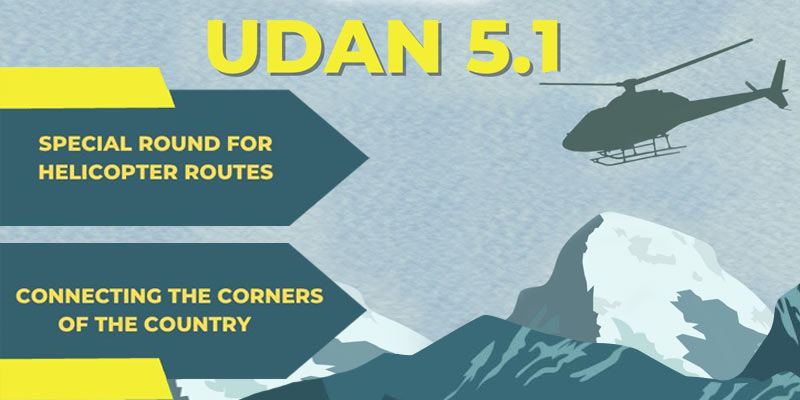- India
- May 26
Govt launches UDAN 5.1
• The ministry of civil aviation has launched UDAN 5.1 to further enhance connectivity to remote areas of the country and achieve last-mile connectivity through helicopters.
• This follows four successful rounds of the Regional Connectivity Scheme (RCS) - Ude Desh Ka Aam Nagrik (UDAN) and with version 5.0 of the fifth round underway.
• Till date, 46 helicopter routes have been operationalised under previous rounds of the scheme benefitting a number of hilly and northeast states and this round is targeting coverage of a much larger number of routes.
• Greater helicopter penetration will help boost tourism, hospitality, and thus, local economies.
What is UDAN scheme?
• UDAN (Ude Desh Ka Aam Nagrik) is a key component of the National Civil Aviation Policy (NCAP), 2016 which was released by the ministry of civil aviation (MoCA) on June 15, 2016.
• The ministry of civil aviation launched RCS-UDAN scheme on October 21, 2016. The first RCS-UDAN flight was inaugurated by Prime Minister Narendra Modi on April 27, 2017 from Shimla to Delhi.
• The primary objective of the regional connectivity scheme (RCS) is to facilitate and stimulate regional air connectivity by making it affordable.
• The regional connectivity scheme will be applicable on route length between 200 to 800 km with no lower limit set for hilly, remote, island and security sensitive regions.
• The scheme is for a period of 10 years.
• The government aims to achieve the target of operationalising as many as 100 unserved and underserved airports and starting at least 1,000 RCS routes by 2024.
• As on February 5, 2023, as many as 459 UDAN routes involving 72 airports including nine heliports and two water aerodromes have been operationalised.
Promoting affordability of Regional air connectivity is envisioned under RCS by supporting airline operators through:
i) Concessions by central government, state governments and airport operators to reduce the cost of airline operations on regional routes.
ii) Financial support (viability gap funding or VGF) to meet the gap, if any, between the cost of airline operations and expected revenues on such routes.
• RCS-UDAN is a demand-driven scheme, where airline operators undertake assessment of demand on particular routes.
Highlights of UDAN 5.1
This round is designed specifically for helicopter routes.
The main features include:
i) An increase in the scope of operations for operators wherein the scheme will now allow routes where one of the origin or destination locations is in a priority area. Earlier, both points had to be in priority areas.
ii) Airfare caps have been reduced by as much as 25 per cent to make flying in helicopters more affordable for passengers.
iii) Viability Gap Funding (VGF) caps for the operators have been increased substantially for both single and twin-engine helicopters to enhance financial viability for operating the awarded routes.
Manorama Yearbook app is now available on Google Play Store and iOS App Store

